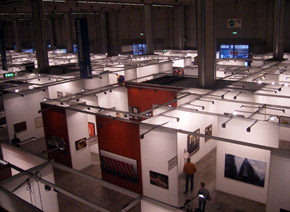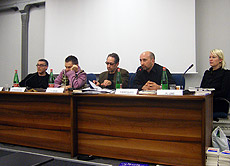|
Press Release
The Utopian Display is a lecture series, held each year at NABA
- Nuova Accademia di Belle Arti di Milano.
The lectures, organised by Marco Scotini and Maurizio
Bortolotti, seek to investigate contemporary exhibition
models, focusing attention on the potential relationships between artistic
and social spheres.

The value of such a discussion is based on the
conviction that, in the last ten years,
the artistic debate has developed through the production of exhibitions on a global
scale. These expositions are also considerations of the idea of
display, a deconstruction of roles and of exhibition
contexts, creating models or alternative platforms to the traditional
practice of exhibiting works of art. The examination of exhibition models
through which ideas of contemporary works of art are built and established is fundamental to the comprehension
of current artistic debate. The question of 'utopian
display' can therefore have a provocative value, but
also reveals the many facets of the problem and the different meanings that the production of exhibitions can
have.
Is an exhibition real or virtual? Or is it a conditional
space? The contemporary artistic panorama is affected by the increasing emergence
of diverse cultures on the worldwide scene and the relationship with the increasing complexity of artistic
work, presenting multiple levels of understanding,
following differentiated paths. A possible approach to further understanding in the
field of contemporary art is certainly determined by the acknowledgement of different curatorial
approaches, which, for their
part, try to define and converge understanding.
The title, The Utopian Display, seeks to be a focal
point around which to extend discourse on contemporary artistic practice and, at
the same time, question the numerous possible interpretations that the invited
curators intend to give to their work. In this way,
the definition of 'utopian display'
is intended as something that expresses the political ideas or the imagination and the liberation of the individual
in an artistic sphere, or it can be interpreted as
'ideal' exhibition that each curator has as a
model, or something else altogether. The title
also intends to offer a point of reference for reflection on contemporary curatorial debate that does not
separate theory from practice and goes right in the heart of this activity.
As such, the series aims to provide some guiding principles to the understanding
of contemporary discourse in the arts, which is affected
by, and at the same time affects, the organisation
of exhibitions.
The primary objective of this conference series is to attempt to trace a map of contemporary curatorial
activity, with an enquiry into the current artistic
landscape. We have therefore chosen the work of
cartographers, through which we have sought to identify a series of curatorial
directions. In the first series of conferences we identified at least three
directions. All these converge and touch the definition of
'utopian display',
assuming the following connotations:
political, aesthetic,
imaginary. In the 'political',
utopia is a place of art in which to experiment with different forms of social relations.
Politically, utopia is a place of art in which one is experimenting with new ways of
creating social relationships between people and their consequent political actions.
In this 'aesthetic',
utopia takes the ideal of works of art that pass through the personal sensitivity of the
curator, and that find a point of reference and interaction in
'sensitive perception' within
context.
|
In the 'imaginary',
utopia is a less focused field in which works of art meet imaginary thoughts that push contemporary society to
transformation, becoming a strong source of meaning.
After the success of the lecture series in 2004 with the participation of Carlos Basualdo,
Hans Ulrich Obrist, Pier Luigi Tazzi and Daniel Birnbaum,
last year The Utopian Display saw the participation of Catherine David, Vasif
Kortun, Hou Hanru, Jens Hoffmann and
Roger M. Buergel.
This year's panel brings Maria Lind, Peter
Lewis, and Raimundas Malasauskas together hosted at the Milan Art Fair under the
moderation of Maurizio Bortolotti and Marco Scotini.
Marco Scotini is an art critic and independent curator.
He lives between Florence and Milan, is Professor of Art History and Coordinator of
the Visual Arts department at NABA. He collaborates with Flash
Art, Tema Celeste and other journals in the field.
Among recent exhibitions he has curated are Beautiful Banners, Prague
2003, Empowerment, Genoa 2004,
Revolutions Reloaded, Milan Berlin 2004, Produciendo
Realidad, Lucca 2004,
Disobedience, Berlin 2005.
Presently he is working on Accion Directa, for the second edition of the 2005 Prague
Biennale. In addition he is responsible for the Gianni Colombo Archive in
Milan.
Maurizio Bortolotti is an art critic and curator.
He collaborates with the department of Sociology at the University of Urbino.
He lives between Brescia and Milan and is the author of the volume Il critico come curatore
(2003). With Stefano
Casciani he curated an anthology of writings by Pierre Restany in Pierre Restany.
Il critico come artista (2004). He led the international
seminars Art Experience for Domus Academy and collaborates with the magazine Juliet e
Domus.

All the lectures will be held at NABA Nuova
Accademia di Belle Arti, Via Darwin 20,
20143 Milano, in the Magna Classroom at
17.30pm. The lectures are free and open to the public.
For further information:
Communication Office NABA
Simona Castagna,
Via Darwin 20,
20143 Milano.
Tel. 02 97372.286, fax 02 97372.280
Email: simona.castagna@naba.it
Press Office NABA
Locomia Chiara Ronzoni,
Via San Damiano 4,
20122 Milano.
Tel. 02 783807, fax 02 76005788
Email:
chiara@locomia.it
La NABA - Nuova
Accademia di Belle Arti Milano is legally recognised by the Italian Ministry of Education,
University and Research (MUIR) and issues the Bachelor of Arts
Honours award in Visual Arts, design, Fashion and textile
Design, graphic Design and Art direction, Media design and theatre
Design.
[ Events ]
|











